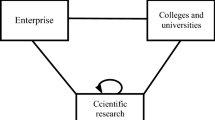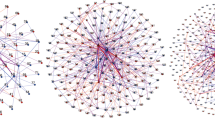Abstract
Taking the industry-university-research cooperative innovation network in the field of new energy vehicles in China as the research object, a model of knowledge creation and diffusion is constructed based on the interaction between network structure and knowledge creation and diffusion. Complex network theory and simulation analysis methods are applied to analyze the evolution law of knowledge creation and diffusion in the industry-university-research cooperative innovation network. The results show that the industry-university-research cooperative innovation network in the field of new energy vehicles has the characteristics of a weighted scale-free network. The overall knowledge level of the network first shows a trend of slow growth and then one of rapid growth, while the growth rate of knowledge first shows a trend of gradually decreasing first and then stable. The greater the degree of the innovator and the higher its knowledge level, the more stable that innovator’s cooperative relationships are and the stronger its knowledge diffusion capacity. The knowledge diffusion model and network structure cause the emergence of sudden changes in the network. Knowledge diffusion constraints and network structure are the keys to knowledge creation and diffusion. With the passage of time, the differentiation among innovators in terms of knowledge level gradually increases, and the role of hub university-research institutions in knowledge creation and diffusion becomes increasingly prominent. Finally, we provide some countermeasures and suggestions to promote the development of the new energy vehicle industry.










Similar content being viewed by others
References
Alchian, A. A. (1950). Uncertainty, evolution, and economic theory. Journal of Political Economy, 58(3), 211–221.
Cao, X., & Liu, G. W. (2014). Study on the evolution of industry-University-Research coopeartive innovation based on game theory and muli-agent simulation. Journal of Systems & Management, 23(1), 21–29.
Cowan, R., & Jonard, N. (2001). Knowledge creation, knowledge diffusion and network structure. Lecture Notes in Economics & Mathematical Systems, 503, 327–343.
Cowan, R., & Jonard, N. (2004). Network structure and the diffusion of knowledge. Journal of Economic Dynamics & Control, 28(8), 1557–1575.
Fritsch, M., & Kauffeld-Monz, M. (2010). The impact of network structure on knowledge transfer: An application of social network analysis in the context of regional innovation networks. Annals of Regional Science, 44(1), 21–38.
Fukugawa, N. (2016). Knowledge spillover from University Research before the national innovation system reform in Japan: Localisation, mechanisms, and intermediaries. Asian Journal of Technology Innovation, 24(1), 100–122.
Gao, X., & Guan, J. (2012). Network model of knowledge diffusion. Scientometrics, 90(3), 749–762.
Gross, T., & Blasius, B. (2008). Adaptive coevolutionary networks: A review. Journal of the Royal Society Interface, 5(20), 259–271.
Havakhor, T., Soror, A. A., & Sabherwal, R. (2018). Diffusion of knowledge in social media networks: Effects of reputation mechanisms and distribution of knowledge roles: Diffusion of knowledge in social media networks. Information Systems Journal, 28(1), 104–141.
Hemphälä, J., & Magnusson, M. (2012). Networks for innovation—But what networks and what innovation? Creativity & Innovation Management, 21(1), 3–16.
Ho, M. H., Lin, V. H., & Liu, J. S. (2014). Exploring knowledge diffusion among nations: A study of core technologies in fuel cells. Scientometrics, 100(1), 149–171.
Huang, W. Q., Zhuang, X. T., & Yao, S. (2012). Study on knowledge diffusion of industry clusters based on the innovation cooperation Network. Journal of Management Science, 25(02), 13–23.
Kelejian, H. H., & Prucha, I. R. (2001). On the asymptotic distribution of the Moran I test statistic with applications. Journal of Econometrics, 104(2), 219–257.
Kim, H., & Park, Y. (2009). Structural effects of R&D collaboration network on knowledge diffusion performance. Expert Systems with Applications, 36(5), 8986–8992.
Konno, T. (2016). Knowledge spillover processes as complex networks. Physica a: Statistical Mechanics & Its Applications, 462, 1207–1214.
Lakpetch, P., & Lorsuwannarat, T. (2012). Knowledge transfer effectiveness of university-industry alliances. International Journal of Organizational Analysis, 20(2), 128–186.
Li, J., & Chang, X. (2013). The influence factors of knowledge transfer: A meta-analytic review. Studies in Science of Science, 31(03), 394–406.
Li, Z. G., Tang, S. K., Liang, X. Y., & Xiao, W. K. (2007). Performance of knowledge innovation and diffusion in the industry clusters based on network structure. Systems Engineering, 5, 1–8.
Li, Z., Tao, Z., & Lai, W. (2010). A study on the knowledge diffusion of communities of practice based on the weighted small-world network. Journal of Computers, 5(7), 1046–1053.
Linares, I. M. P., De Paulo, A. F., & Porto, G. S. (2019). Patent-based network analysis to understand technological innovation pathways and trends. Technology in Society, 59, 101134.
Liu, X., Jiang, S., Chen, H., Larson, C. A., & Roco, M. C. (2015). Modeling knowledge diffusion in scientific innovation networks: An institutional comparison between China and US with illustration for nanotechnology. Scientometrics, 105(3), 1953–1984.
Liu, M., Ma, Y., Liu, Z., & You, X. (2017). An IUR evolutionary game model on the patent cooperate of Shandong China. Physica a: Statistical Mechanics and Its Applications, 475, 11–23.
Liu, J. G., Yang, G. Y., & Hu, Z. L. (2014). A knowledge generation model via the hypernetwork. PLoS ONE, 9(3), e89746.
Liu, J. G., Zhou, Q., Guo, Q., Yang, Z. H., Xie, F., & Han, J. T. (2017). Knowledge diffusion of dynamical network in terms of interaction frequency. Scientific Reports, 7(1), 1–7.
Luo, S., Du, Y., Peng, L., Xuan, Z., & Wang, Y. (2015). A study on coevolutionary dynamics of knowledge diffusion and social network structure. Expert Systems with Applications, 42(7), 3619–3633.
Madani, F., & Weber, C. (2016). The evolution of patent mining: Applying bibliometrics analysis and keyword network analysis. World Patent Information, 46, 32–48.
Mao, Y. L., & Wang, F. (2018). Spatial correlation in evolution of regional comparative advantages: Evidence on the impact of knowledge diffusion. China Industrial Economics, 11, 136–154.
Mueller, M., Bogner, K., Buchmann, T., & Kudic, M. (2016). The effect of structural disparities on knowledge diffusion in networks: An agent-based simulation model. Journal of Economic Interaction & Coordination, 12(3), 613–634.
Newman, M. E. (2001). Scientific collaboration networks. I. Network construction and fundamental results. Physical Review E, 64(1), 16131.
Niemann, H., Moehrle, M. G., & Frischkorn, J. (2017). Use of a new patent text-mining and visualization method for identifying patenting patterns over time: Concept, method and test application. Technological Forecasting and Social Change, 115, 210–220.
Phelps, C., Heidl, R., & Wadhwa, A. (2012). Knowledge, networks, and knowledge networks a review and research agenda. Journal of Management, 38(4), 1115–1166.
Simon, H. A. (1997). Models of bounded rationality: Empirically grounded economic reason (Vol. 3). MIT Press.
Singh, J. (2005). Collaborative networks as determinants of knowledge diffusion patterns. Management Science, 51(5), 756–770.
Sorenson, O., Rivkin, J. W., & Fleming, L. (2006). Complexity, networks and knowledge flow. Research Policy, 35, 994–1017.
Traulsen, A., & Nowak, M. A. (2006). Evolution of cooperation by multilevel selection. Proceedings of the National Academy of Sciences, 103(29), 10952–10955.
Tur, E. M., & Azagra-Caro, J. M. (2018). The coevolution of endogenous knowledge networks and knowledge creation. Journal of Economic Behavior & Organization, 145, 424–434.
Wang, J. (2016). Knowledge creation in collaboration networks: Effects of tie configuration. Research Policy, 45(1), 68–80.
Wang, W. P., & Zhang, B. (2013). Emergence characteristics of knowledge flow in knowledge networks under dynamic relationship strengths. Journal of Management Sciences in China, 16(2), 1–11.
Xie, X., Fang, L., & Zeng, S. (2016). Collaborative innovation network and knowledge transfer performance: A Fsqca approach. Journal of Business Research, 69(11), 5210–5215.
Yang, G., Hu, Z., & Liu, J. (2015). Knowledge diffusion in the collaboration hypernetwork. Physica a: Statistical Mechanics and Its Applications, 419, 429–436.
Yu, X. Y., Zeng, D. M., Chen, Y. L., & Wang, J. Y. (2013). Modeling and simulation of the knowledge increase process in the technology innovation network. Science Research Management, 34(10), 35–41.
Zhang, L., Wei, Q., Yuan, Y., & Li, Y. (2019). Knowledge diffusion simulation of knowledge networks: Based on complex network evolutionary algorithms. Cluster Computing, 22(6), 15255–15265.
Zheng, W., Pan, H., & Sun, C. (2019). A friendship-based altruistic incentive knowledge diffusion model in social networks. Information Sciences, 491, 138–150.
Zhou, W., Chen, W., & Lang, Y. F. (2014). Modeling and simulation analysis of process of knowledge innovation and diffusion based on industry cluster innovation network. Operations Research and Management Science, 23(06), 257–265.
Zhou, W., Chen, W., & Lang, Y. F. (2015). Knowledge dynamic growth in the innovation network of industrial cluster: Based on process perspective. Journal of System Engineering, 30(04), 431–441.
Zhu, G. L., & Peng, Y. F. (2003). The research on organization mode and operation mechanism of Innovation Network in Cooperation of Industry University and Research Institute. Soft Science, 489(1), 85–94.
Acknowledgements
We acknowledge the financial support provided by the National Natural Science Foundation of China (Grant No. 71473055) and Harbin Engineering University Scholarship Fund. At the same, we acknowledge the academic support provided by Xia Cao’s work paper (https://assets.researchsquare.com/files/rs-107986/v1_stamped.pdf).
Author information
Authors and Affiliations
Corresponding author
Rights and permissions
About this article
Cite this article
Cao, X., Li, C., Li, J. et al. Modeling and simulation of knowledge creation and diffusion in an industry-university-research cooperative innovation network: a case study of China’s new energy vehicles. Scientometrics 127, 3935–3957 (2022). https://doi.org/10.1007/s11192-022-04416-4
Received:
Accepted:
Published:
Issue Date:
DOI: https://doi.org/10.1007/s11192-022-04416-4




